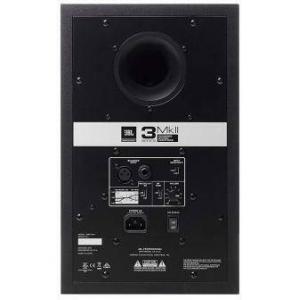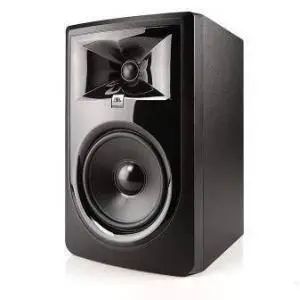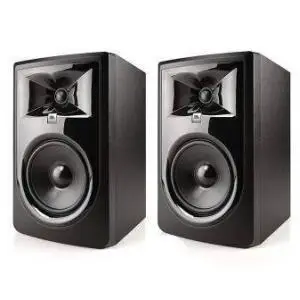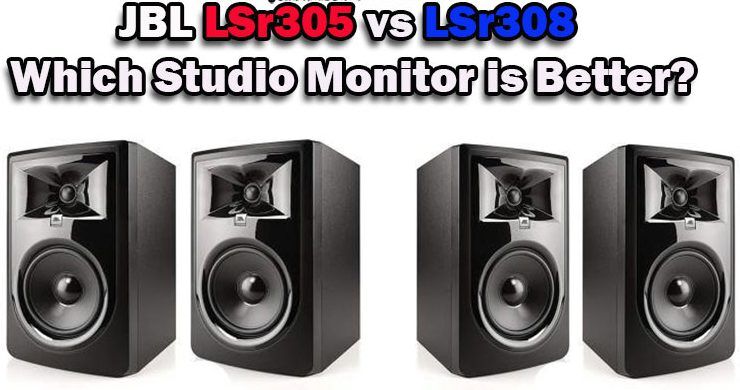Table of Contents
JBL has dedicated 70 years to the development of professional studio monitors. The company has combined style and quality in each product, especially with the LSr305 and the LSr308. These studio monitors are powerful yet they are modern looking to blend in with today’s studios.
We are going to look at the specifics of the LSr305 vs LSr308. We will discuss their sound capabilities, connectivity, and their appearance. All of the details will be put in a comparison chart for easy viewing, and we will finish up with some of the pros and cons of each.
Let’s start with how the LSr305 and the LSr308 are similar. As they are both from the new 3-Series, there will be several.
JBL LSr305 Vs LSr308 – Similarities
Quick Glance


The Traducers
The traducers in both the LSr305 and the LSr308 have been improved for optimized damping. You can experience a better transient response, excellent deep bass and lower distortion. In terms of numbers, the two studio monitors have a trim control of +2dB, 0dB, -2dB. This provides perfect control of treble and bass.
Patented Image Control Waveguide
This newly designed waveguide accurately controls the sound that the speaker emits both in the vertical and horizontal positions. When you are listening, you can appreciate a neutral and accurate sound. This is room friendly and gives you more depth when recording. You will notice even the tiniest detail in dense mixing.
Connectivity
Regardless of whether you choose the LSr305 or the LSr308, you will be able to connect the audio monitor to a range of inputs. First, there is a balanced XLR. There are also 1/4 inch TRS inputs and a +4dBu/-10dBV input sensitivity switch.
Boundary EQ
This is another feature that has been upgraded. The new boundary EQ restores a neutral low frequency for different monitor positions. You can place these monitors on work surfaces and next to walls without affecting the sound. This new design also allows you to use the studio monitors new magnetically sensitive equipment.
Frequency Port
JBL’s Patented Slipstream low-frequency port works in conjunction with the woofer for abetter deep bass response. The shape is double-flared and is designed for better low-frequency extension and less turbulence.
The differences between the LSr305 and the LSr308 are very much based on the size of the studio monitors. We will start with the design.
Differences Between LSr305 and LSr308
Appearance

It’s obvious that you are looking at studio speakers, although the waveguide makes them look unique from others.
LSr305
The studio monitor is black. The matte finish on the front is a nice touch, adding to the design. There is a 5-inch transducer and a 1-inch dome tweeter made of damped woven Neodymium composite. Overall, the monitor is 14 x 12.2 x 13.9 inches and weighs 10.12 pounds.
LSr308
Similarly, it is black with a matte finish. The transducer is now 8 inches, but the dome tweeter and materials are the same. It measures 14.6 x 12.8 x 18.6 inches and weighs 18.9 pounds.
The Winner Is- A Tie
Frequencies

We have looked at the frequency range (the actual frequencies a monitor can reproduce) and the frequency response (the frequency range versus the amplitude).
LSr 305
This monitor has a frequency range of between 43Hz to 24KHz. Its frequency response is from 49Hz to 20KHz.
LSr 308
Being larger, you can expect a greater range and response, although it’s not that much more. The frequency range is 37Hz to 24KHz and the frequency response is 45Hz to 20Kh.
The Winner Is- The LSr 305
Maximum SPL

The SPL is the Sound Pressure Level. It is the highest level of sound pressure a monitor can handle before you notice the distortion.
LSr305
The peak SPL is 108dB, a little bit less than the sound of an aircraft taking off.
LSr308
The maximum SPL is 112dB, slightly more than an aircraft taking off.
The Winner Is- The LSr 308
Read next: Yamaha Hs8 vs Adam A7X: Which Studio Monitor is Better?
Power

It is estimated that 60 watts are a good amount of power for an average-sized room in your home. The power of both of these studio monitors makes them suitable for home use or professional use.
LSr305
The dual integrated, custom Class-D amplifiers produce a total of 82 watts.
LSr308
While it also has dual integrated, custom Class-D amplifiers, the total watts is now 112.
The Winner Is- The LSr 308
Pros and Cons
The following pros and cons will help to give a clearer picture of the audio monitors before we offer the final verdict.
LSr 305

Pros:
- This is good for entry-level monitor
- Incredibly responsive bass
- Amazing value for money
Cons:
- Some people have heard a hissing sound from the amplifier
LSr 308

Pros:
- Great sound detail compared with other brands of 8” monitors
- Excellent dynamic range
- No distortion at very loud volumes
Cons:
- They are massive, so you need to make sure you have the space in your work area
The Final Verdict
Today, we are choosing the LSr308. That being said, if you don’t want to spend the extra money or you don’t feel you have space at home, the LSr305 is a perfect little studio monitor.
Overall, we felt the extra money was worth it because even then, the LSr308 is still an excellent buy compared with similar monitors. The monitor has the right amount of power and frequency range to produce a perfectly clear sound across a great array of music types. It looks smart, it has impressive technology and as well as being able to use it at home, it is a much better choice for professionals.
Last update on 2024-04-18 / Affiliate links / Images from Amazon Product Advertising API
